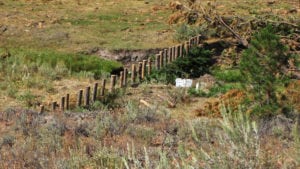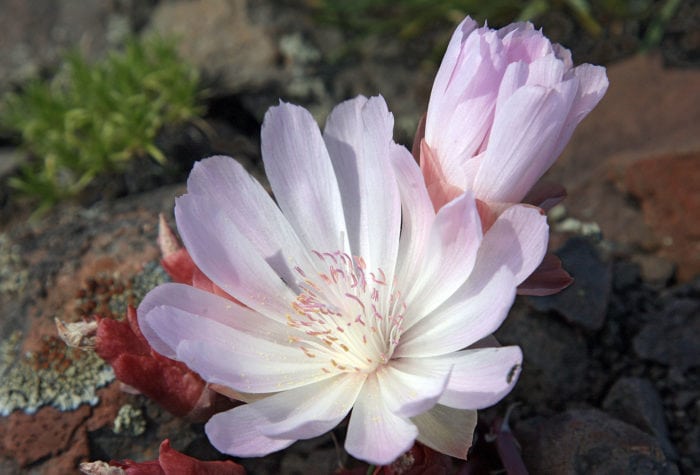Wiwaanyatt Creek Riparian Restoration November 1-4
Sage Brown Website
| Organizer: Jefferson Jacobs
Start Date: 11/1/2018 End Date: 11/4/2018 Region: John Day River Basin Difficulty Rating: 3 out of 5 Maximum Group Size: 15 participants |
About the place
ONDA has been involved with legal action supporting fish habitat in Malheur National Forest for over a decade, and we are now pleased to be entering a new cooperative phase with the National Forest where we are now in the third year of helping to implement a variety of ambitious, multi-year projects restoring key fish habitat on headwater streams.
Wiwaanyatt Creek has its headwaters just east of Prairie City and is a tributary of the Middle Fork of the John Day River. The Creek provides critical habitat for steelhead. Currently the stream has eroded banks, little to no woody riparian vegetation, has numerous obstructions to fish migration, and is not connected with its floodplain. We are now in our third year of helping out on projects on this creek. This is a big exciting project! Culverts are being replaced; old weirs will be refurbished or removed to avoid obstruction to fish passage; extensive lengths of obsolete irrigation channels will be back-filled; sections of creek will be returned to its historic channels; large woody debris and pools will be added; trees encroaching on the floodplains will be removed; Beaver Dam Analogues (BDAs) will be installed and extensive riparian planting will be conducted. ONDA volunteers will be responsible for building structures on the floodplain that will catch sediment during seasonal flooding.
If all goes according to plan, over time the project area will become a shaded stream with cool water that will encourage native fish species and discourage non-native fish species. Woody species will be plentiful enough to provide a useful source of browse for deer, elk and beaver. If the stream is reconnected with its floodplain and the former wet meadows are effectively inundated, the 86-acre project area could store more than 38 million gallons of water that could be slowly re-released over the course of the later summer to maintain cool water temperatures and flows.
View the map.
About the stewardship work
 ONDA volunteers will be constructing various structures on the floodplain. The structures are made of wooden posts driven into the ground, with willows woven into the posts, or rocks and cobble layered among the posts. During high seasonal flows, these structures will help trap sediment, direct flows to side channels and in general help more water stay in the water table longer so it will cool, and be available during the summer dry season.
ONDA volunteers will be constructing various structures on the floodplain. The structures are made of wooden posts driven into the ground, with willows woven into the posts, or rocks and cobble layered among the posts. During high seasonal flows, these structures will help trap sediment, direct flows to side channels and in general help more water stay in the water table longer so it will cool, and be available during the summer dry season.
The importance of the work we are doing also has many impacts beyond the immediate and structures we install. Having ONDA volunteers help out on this project is a great way to demonstrate ONDA’s long-term and meaningful commitment to the fish habitat that we have been working to protect for two decades; it is also a fantastic way to continue building the cooperative atmosphere with the National Forest. And by formally committing to cooperate together we are able provide volunteer hours as “matching” for the grant funding the restoration project. This greatly increases the magnitude and impact of the project.
As always there is no experience necessary. We will teach you everything you need to know to work safely and effectively. There is ample opportunity to work at your own pace and on aspects that work best with your physical capabilities.
Trip timeline
- Thursday, November 1, 6 p.m.: Meet at the campsite (directions will be sent in 3-week email before trip). Get settled in, and have an orientation talk with details about the work over the next two days.
- Friday, November 2, 8 a.m.: Head to the worksite. We will be away from camp all day, returning between 4 and 5 p.m.
- Saturday, November 3, 8 a.m.: Head to the worksite. We will be away from camp all day, returning between 4 and 5 p.m.
- Sunday, November 4, 9 a.m.: After breakfast we can pack up and head home.
Camp
This trip will involve car camping at an undeveloped National Forest campsite. ONDA will provide a porta-potty. There will be no potable water source. There will be plenty of room to spread out in terms of tent sites, but we will gather in the evenings and the mornings to be able to share information about the work and for some social time. The campsite is accessible via gravel roads in a standard vehicle: no 4WD required.
Difficulty
While pounding the posts with the hydraulic pounder will be very hard work and noisy, there are plenty of other things that will need to be done, such as cutting and hauling brush and moving gravel or rocks. However, everyone can pace themselves and regulate their own level of effort, switch between various available tasks of varying intensities and rest as needed.
Trip highlights and challenges
- Helping to dramatically change a large watershed for the benefit of fish and wildlife.
- Working in a lovely high elevation eastern Oregon forest.
- Easy comfortable car camping situation.
- Ability to self-engage at an effort level of work that is as light or as challenging as desired.
Participant responsibilities
Participants are responsible for their own food and camping gear, as well as transportation to and from the trip. Sturdy off-trail ankle-high boots are required for this trip. Participants should be prepared with clothing layers, food and water to spend the day away from camp to conduct the work. We recommend bringing your own work gloves to provide a comfortable fit. But it is not required. We recommend that each person bring 2 to 3 gallons of drinking water for the trip, since none is available on site.
Gear provided
ONDA will provide the tools for the work (Including work gloves if you don’t have a pair), excellent guidance in the field, and a few group camping items to make things more comfortable (chairs, tables, dishwashing bins, campfire materials, shade/rain tarp, etc.) We also provide hot water at morning and evening mealtimes to help expedite meal prep, and espresso coffee in the morning.
Registration
An ONDA registration application and medical form are required for this trip.
Apply Now
You only need to fill this form out once per year and can join additional trips this year by emailing the trip leader directly. You will receive a confirmation email within 10 working days of submitting your form. The confirmation email will provide information regarding which trips you are on the “participant list” for, and which trips are full, and therefore you have been placed on the “waitlist.”
Six weeks before the start of the trip, the trip leader will send out an RSVP to make sure everyone is still able to participate. Based on RSVPs, open spaces will be backfilled with people from the waitlist.
Three weeks before the trip start date, registered and confirmed participants will receive driving instructions, maps, carpooling options, and additional information in an email sent by the trip leader
If you have any questions in the meantime, please don’t hesitate to contact the trip leader.
This trip will be led by ONDA's Riparian Restoration Coordinator Jefferson Jacobs. For questions about the trip call (541) 330-2638 or email jjacobs@onda.org.
ONDA's Restoration and Stewardship Work
Over the last two decades, ONDA has engaged volunteers in projects to plant thousands of trees, restore dozens of miles of streams, decommission old roads, and remove enough barbed wire […]
Read More